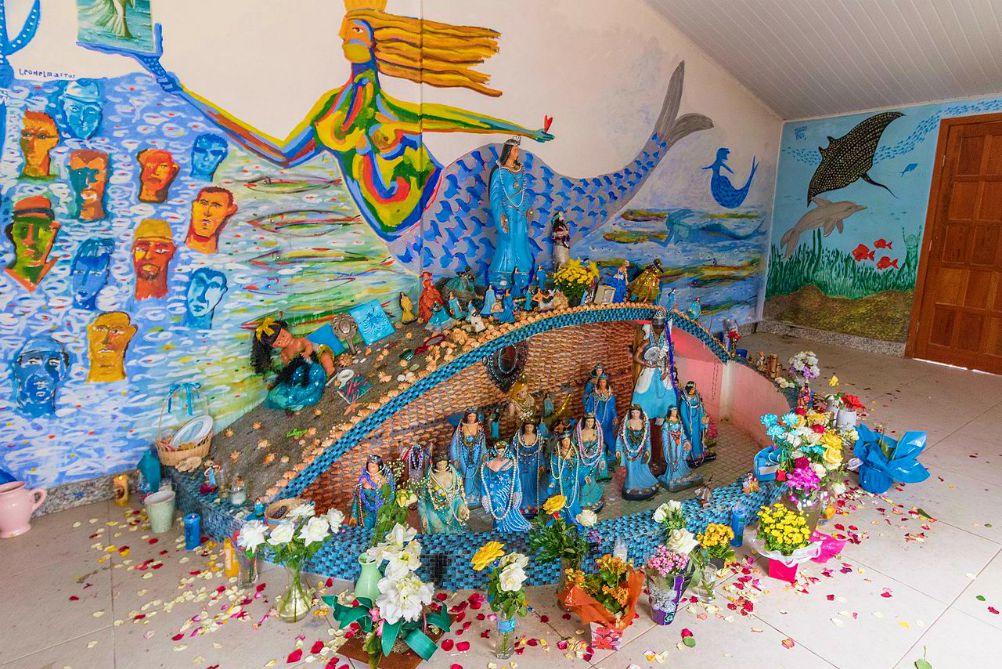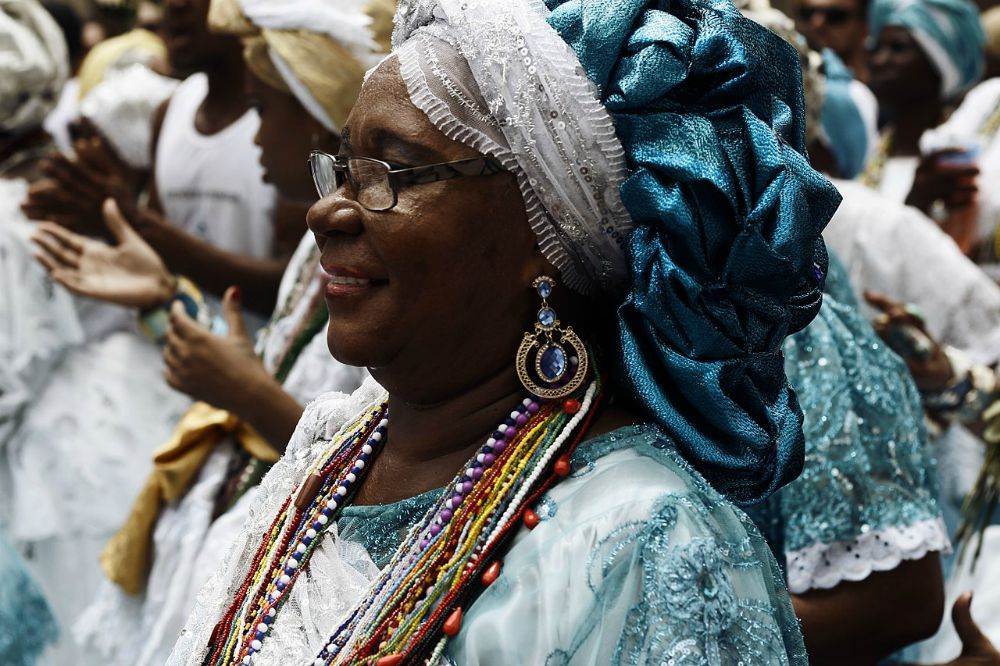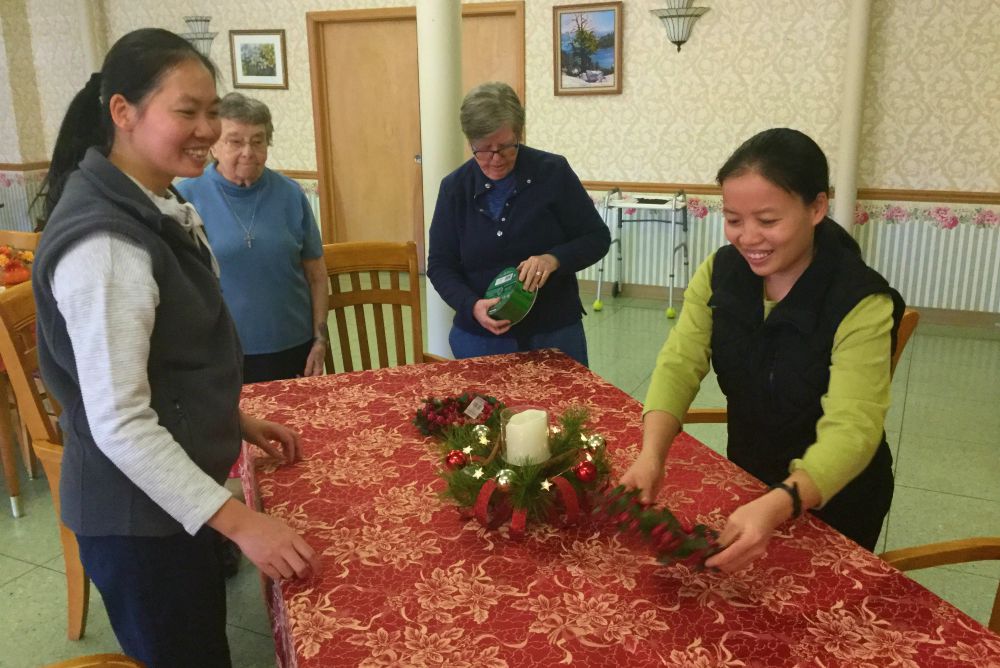
Sisters of Jesus Crucified Councilor Sister Paulina and Sister Nga Nguyen decorating for Christmas. For the past 10 years sister-students of various Vietnamese congregations who have enjoyed the hospitality of the Brockton community over the winter holidays. (Barbara Valuckas)
The panelists shared glimpses of what it is like to celebrate the new year in their convents and cultures, giving us global flavors from Lithuania, Vietnam, Brazil, South Africa, Zimbabwe and the United States as they responded to this prompt:
Share some customs that you, your congregation or your culture practice around Jan. 1 (or the beginning of a new year, however you designate it).
______
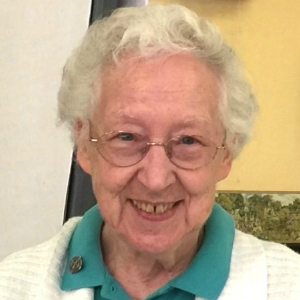 Barbara Valuckas, a School Sister of Notre Dame based in Connecticut, has a communications background. She taught in schools and via educational television in the Diocese of Brooklyn, New York. Both before and after serving in province leadership as councilor and provincial leader, she has been ministering as a facilitator and consultant for parishes in the United States and with religious congregations internationally.
Barbara Valuckas, a School Sister of Notre Dame based in Connecticut, has a communications background. She taught in schools and via educational television in the Diocese of Brooklyn, New York. Both before and after serving in province leadership as councilor and provincial leader, she has been ministering as a facilitator and consultant for parishes in the United States and with religious congregations internationally.
It is Christmas Eve, and the Sisters of Jesus Crucified in Brockton, Massachusetts, have gathered with their Lithuanian friends for the traditional meal and ritual. During the decades of Soviet occupation of Lithuania, Christmas Eve and Christmas Day were workdays, and the ritual could be observed only clandestinely, if at all. But Lithuanian American congregations in the United States preserved the ritual, some parts of which may have roots in pre-Christian Lithuania.
Since Christmas Eve was a fast day, the celebrative meal and ritual was meatless. Participants did enjoy 12 dishes (to honor the 12 apostles) of various kinds of fish along with potatoes, beets, onions, mushrooms, cranberry pudding and poppyseed milk. Each participant was also given a large blessed wafer, which was then broken into pieces and shared with the other participants while asking forgiveness for any hurts during the past year. Having made peace with each other, everyone was then spiritually ready to participate in the midnight Mass.
For the past 10 years, there have been other participants in the ritual, sister-students of various Vietnamese congregations who have enjoyed the hospitality of the Brockton community while studying nearby. In their communist country, Christmas Eve and Christmas Day are still workdays, although the sisters are free to observe those days in their convents. They appreciate the opportunity to learn the Christmas customs from Lithuanian culture. And they know how to reciprocate with their New Year's celebration!
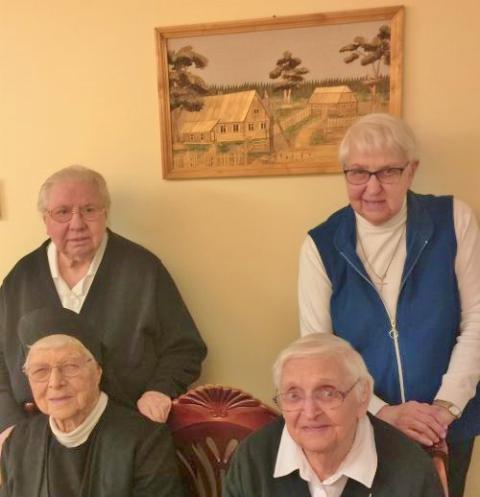
Lithuanian-American Sisters of Jesus Crucified pose with some Lithuanian "straw art" displayed on their motherhouse walls. Front row: Sisters Joan of Arc and Helen; back row: Sisters Stephen and Helen. The sisters make up a part of the team of teachers and mentors who help their Vietnamese student- sister guests. (Barbara Valuckas)
As an Asian culture, the Vietnamese celebrate the Lunar New Year with up to two weeks of festivities. In Vietnam, the New Year's observance is more of a family event than a community event. It is the only time the sisters can spend an extended time with their families. But for the sister-students, the Sisters of Jesus Crucified in Brockton have become their family.
Even sisters on scholarships for advanced studies outside of Massachusetts routinely ask to come "home" for the holidays. There, the sister-students become the teachers of their host community as they share their Vietnamese food and New Year's customs.
The Sisters of Jesus Crucified congregation is small now, with fewer than a dozen sisters living in the motherhouse or in the nearby nursing home. But several years ago, the sisters made a chapter commitment to "live fully until the last sister dies," in contrast to focusing on their future completion. It was this commitment that led them to offer hospitality to the Vietnamese congregations.

Vietnamese sister-students touch the shoulders of their respective Sisters of Jesus Crucified hostesses, teachers and mentors. (Barbara Valuckas)
Each sister serves as an English teacher and mentor for a group of Vietnamese sisters. Superior General Mary Valliere makes sure the Vietnamese sisters have warm clothes for the cold months and warm support in their struggles with the English language and U.S. culture. Her own sisters, mostly in their 80s and 90s, are delighted with their new students, whose joy and energy are helping them to live fully. This is the kind of mutual gift exchange that lasts beyond the holidays and endures into the future.
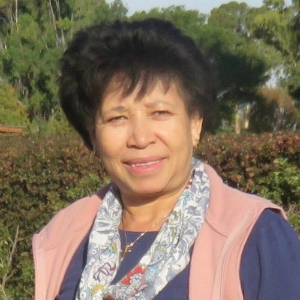 Katy van Wyk, a Dominican Sister of St. Catharine of Siena of King William's Town, South Africa, lives in Johannesburg. After teaching, she served in leadership as team member and assistant leader, later continuing in mission effectiveness for Dominican schools. Now she conducts retreats, volunteers as a community art counselor with underprivileged children, and facilitates empowerment workshops for young women at risk of teenage pregnancy, drug or alcohol abuse, and physical/sexual abuse.
Katy van Wyk, a Dominican Sister of St. Catharine of Siena of King William's Town, South Africa, lives in Johannesburg. After teaching, she served in leadership as team member and assistant leader, later continuing in mission effectiveness for Dominican schools. Now she conducts retreats, volunteers as a community art counselor with underprivileged children, and facilitates empowerment workshops for young women at risk of teenage pregnancy, drug or alcohol abuse, and physical/sexual abuse.
As I write this piece, the morning is fresh and still, apart from the sound of soft rain. In Johannesburg, we were surprised to be blessed these last five days by the heavens just opening, gently, abundantly.
The beginning of a new year is a bit like that for me: Gently and seamlessly, the days flow from one to the next, each day bringing us closer to the last day and the first day of the year. When I was growing up, from 11 a.m. to midnight, the whole family gathered at the family home, singing, praying and thanking God for all our experiences — both joyous and painful — and asking God's blessings for the coming year. The last five minutes were silent, the radio or TV set turned on so we could hear the countdown. Then at 12 o'clock, we would wish one another a Happy New Year! Early on New Year's morning, we would go to visit the graves of our family members.
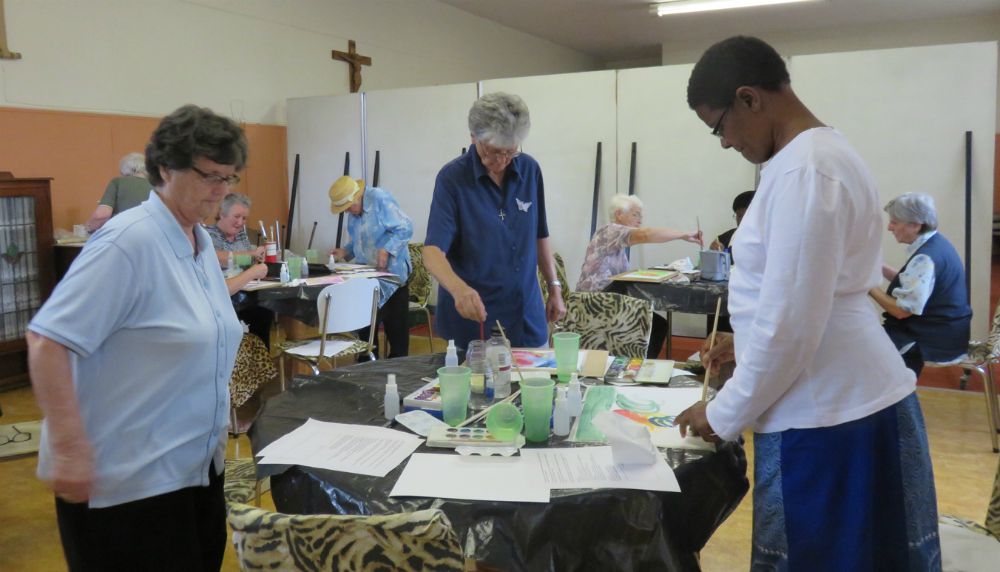
Some of Dominican Sisters of St. Catharine of Siena of King William's Town, South Africa, paint their "hopes" for the new year. Some sisters frame these pictures and keep them on cupboard or refrigerator doors as a reminder. (Katy Van Wyk)
Much has changed, though family and friends still get together on New Year's Eve, celebrate and wait for the clock to strike. In some cultures, the first of January is spent at the beach, some believing it important to get into the water to "wash off" all the negativity from the previous year. Containers are filled with water to take home for those who could not go to the beach. This is drunk, with the same idea to cleanse.
In my community, some of us may gather on the last day of the year for reflection and prayer. Some time ago, we added a ritual: After first making our reflection on the year, we then express in color what we hope for the new year. On New Year's Day, all of us gather at our retirement home, celebrating Mass and then enjoying a braai (barbecue) with the sisters there.
Whatever the changes, this is a day to celebrate with family, friends and communities. May we all be blessed by our generous God of surprises throughout this new year.
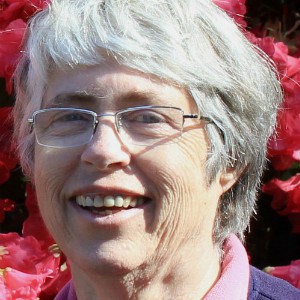 Sheila Campbell is a Medical Missionary of Mary sister of Irish and Brazilian nationality. After an early nursing ministry in Ireland, she did nursing, health education, parish work, and pastoral health care work (specializing in HIV/AIDS) as a missionary in Brazil. She later served in congregational administration in Ireland, and in Brazil, with families affected by urban violence and prostitution. Currently, she serves sick and elderly sisters at her congregation's home in Massachusetts.
Sheila Campbell is a Medical Missionary of Mary sister of Irish and Brazilian nationality. After an early nursing ministry in Ireland, she did nursing, health education, parish work, and pastoral health care work (specializing in HIV/AIDS) as a missionary in Brazil. She later served in congregational administration in Ireland, and in Brazil, with families affected by urban violence and prostitution. Currently, she serves sick and elderly sisters at her congregation's home in Massachusetts.
For several years, I lived in Salvador, a seaside city in the northeast of Brazil in Bahia State where our congregation ministers. New Year's was a special time for us as it was a time to mix and mingle with people of other religious traditions.
New Year's Eve began in the usual Catholic tradition, with the vigil Mass for Mary, mother of God. But it also celebrated the World Day of Peace, so everyone came to the church dressed in white. The liturgy is enthusiastic, often with singing, dancing and waving banners promoting peace. New Year's greetings were passed around among the parishioners, the final blessing given and then —
Then a whole new celebration began!

An offering on the beach of São Vicente , São Paulo, Brazil, for Yemanjá, Dec. 31, 2010 (Flickr/TwistSim)
Salvador is a city that has been marked by the African slave trade; almost 80% of the population is Afro-Brazilian. As newly arrived slaves, they were forcibly baptized as Catholics, and their own religious traditions ignored and persecuted. Of course, these traditions did not disappear but were practiced secretly under the guise of devotion to the saints! Thus, Oxalá became Jesus Christ; Yemanjá, the orixá of the waters and oceans, became Mary, Star of the Sea, and so on. Only since 1970 has Candomblé (a blend of Yoruba, Fon and Bantu traditions) been allowed to be practiced openly. And New Year's night is a night of special celebration.
After Mass, we would go down to the beach. Most of our neighbors would come out of their houses, too, and begin streaming in the same direction. Chatting and laughing, we would make our way, each one carrying something to eat or drink. Once on the beach, there would be a quieting of the atmosphere. Those of the Candomblé faith, also dressed in white, would hold their own ceremonies of song and dance. They would bring small offerings of flowers or candles to the sea to honor Yemanjá. We would also touch the waters and bless ourselves and pray for the year to come. The civil authorities would have a fireworks display in the more affluent areas, but from our poor neighborhood, we could see them, too, and enjoy the show!
New Year's celebrations were a good example of interreligious dialogue held in a harmonious and simple way. No theological discourse, no studied civility! Just passing back and forth food and drink and sharing a joyful moment of celebration.
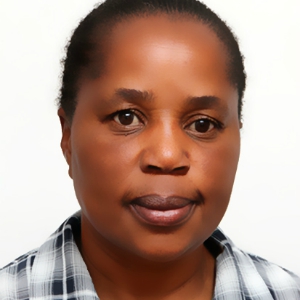 Monica Nyachowe is a Dominican Missionary Sister of the Sacred Heart of Jesus from Zimbabwe. She has more than 20 years of experience in teaching and administration of schools at various levels, including as school head of the Dominican Convent School in Harare. Her academic work included early childhood education, educational leadership, management and policy. She moved into university teaching in educational studies and currently teaches at Arrupe Jesuit University in leadership and governance.
Monica Nyachowe is a Dominican Missionary Sister of the Sacred Heart of Jesus from Zimbabwe. She has more than 20 years of experience in teaching and administration of schools at various levels, including as school head of the Dominican Convent School in Harare. Her academic work included early childhood education, educational leadership, management and policy. She moved into university teaching in educational studies and currently teaches at Arrupe Jesuit University in leadership and governance.
The beginning of a new year for our Dominican congregation is a time for giving thanks: thanksgiving for the year ended and thanksgiving for the new year just starting. Customarily, a list is put up in the first week of Advent for sisters to volunteer to prepare a special liturgy for each week in Advent and the beginning-of-the-year celebration. We take these celebrations seriously in that we take a lot of time preparing for the celebration, and we all look forward to the reflection.
The New Year's celebration usually involves a looking back at what the year has been and giving thanks. As part of the celebration, we also have a time to ask for forgiveness from each other. We then give each other a sign of peace.
After that, we have a short reflection on how the year has been. Some highlights — positive and negative — are shared. Some of the highlights we share are on community life, apostolates, and our involvement in the life of the local church. Of course, social and political issues are always shared because we are affected by what happens in our country.
We conclude the celebration and usher in the new year by commending the coming year to the Lord, asking for his guidance and protection. After a reflection in the community room, we make an hour's adoration of the Blessed Sacrament until midnight. When the clock strikes 12, we wish each other a happy and blessed New Year and have a little drink before going to bed.
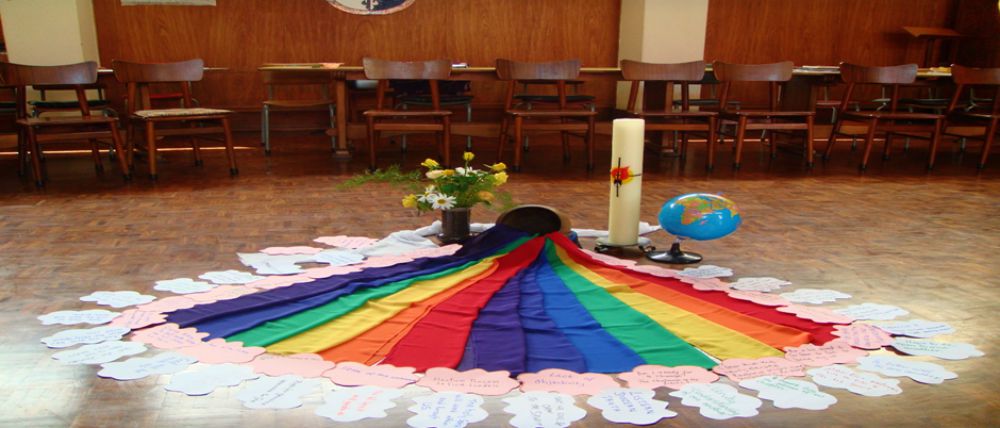
A centerpiece prepared for a new year's celebration ritual by one of the Dominican Missionary Sister of the Sacred Heart of Jesus (Dominican Sr. Ferrera Weinzierl)
In some instances, we exchange gifts, presenting a gift to the sister for whom we have been praying throughout the year (or since the beginning of Advent). It is always an exciting moment to discover who has been praying for you, because it might help recall some special events of the year: For example, the sister might have been extra kind or looked out for you when you were away from the community.
Each community does this differently and in a creative way that suits their situation. This practice in our convents is similar to the practice in our country, when families come together to celebrate the end of the year. The difference is that our families generally do not focus so much on the religious side; they focus on thanksgiving with lots of loud music and dancing, drinking beer, braai (barbecue) and cooking local and traditional dishes. This kind of celebration goes on from New Year's Eve until the following day in the evening.
Advertisement
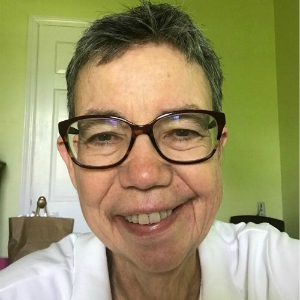 Catherine Soley is a member of the Religious of the Assumption. A "late vocation," she has two daughters and two grandsons. Her ministries have included teaching and directing an English-as-a-second-language program, helping with after-school mentoring, working with college students and elementary-age children of recent immigrants, and overseeing the community garden. Currently living in Lansdale, Pennsylvania, she is the primary caregiver for her mother, practices spiritual direction and serves as provincial councilor.
Catherine Soley is a member of the Religious of the Assumption. A "late vocation," she has two daughters and two grandsons. Her ministries have included teaching and directing an English-as-a-second-language program, helping with after-school mentoring, working with college students and elementary-age children of recent immigrants, and overseeing the community garden. Currently living in Lansdale, Pennsylvania, she is the primary caregiver for her mother, practices spiritual direction and serves as provincial councilor.
Looking back, my fondest memories of New Year's celebrations are good times shared with friends.
Life with the Assumption Sisters, an international congregation, among sisters from four continents has added various cultural expressions to more familiar traditions. Living in authentic community has enabled us to weave this diversity into beautiful liturgical expressions of our religious and very human lives.
In the soft glow and crackling sounds of a fire, we come as sisters to recall with gratitude what we have lived together and to ask blessings on all that will be. This contemplative reading of our year begins with listening to the names, faithfully compiled in our book of visitors, of those who have come through our door, enriching our lives. Names trigger stories, relived in the telling and seen now from one another's perspective.
Gradually, the narrative shifts, becoming more personal: the death of a parent, renewal of vows, birth of a grandchild, conflicts in relationships. The telling of our stories in the context of community allows for an encounter with self — and with others — that reveals difficult truths. Trusting community, moving into this vulnerable place, ultimately brings ever deeper joy and strengthens bonds among us.
The warrior strength to engage on this level is rooted in the commitment to live genuine community. The Spirit accepts the threads we offer — frayed, fragile, brittle, broken — drawn from the everyday, from lives shared over time; from these, she weaves a complex pattern. The strength and resiliency of this fabric, lifted to our God and offered to the world, surprises even us! This manner of living creates a safe space where, in moments that become sacred, deep sharing can happen. It is by then extending this space to those who come that widens the circles in which we live.
Voices become quiet as we move into the stillness of our chapel. Candlelight illuminates the Blessed Sacrament, directing our gaze. We come to witness the passing of one year into the next, to give thanks for what has been and for all that will be. Vocal prayers are brief. We listen as the names of our sisters who have gone to God this past year are read. We name our fears and articulate our dreams for our world, for our people, and for each other. In silence, we linger, to simply be together in the presence of the One who has called us.

